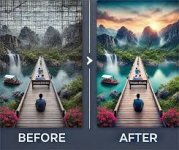In the era of high-definition displays and immersive visual experiences, low-resolution graphics can be a significant setback. Whether it's an old video game, a grainy security feed, or a degraded digital image, poor resolution can limit usability, clarity, and engagement. However, advancements in artificial intelligence (AI) and computer graphics have introduced transformative solutions for enhancing such visuals in real time.
At the core of this innovation are AI-powered upscaling techniques. These models, particularly super-resolution neural networks, are designed to reconstruct high-resolution details from low-resolution inputs. Deep learning models such as ESRGAN (Enhanced Super-Resolution Generative Adversarial Network), FSRCNN (Fast Super-Resolution Convolutional Neural Network), and more recently, real-time video enhancement algorithms, are capable of adding missing pixels, sharpening edges, and restoring fine details with remarkable accuracy.
The role of computer graphics in this AI-driven process is pivotal. Once AI predicts or generates enhanced data, it is through graphics engines that these improvements are rendered in real time—be it on a video stream, animation, or interactive application. For instance, when integrated into gaming engines, these tools allow older games or low-spec models to be visually upgraded without rebuilding the entire asset library.
One major use case is in real-time video conferencing. Many users still deal with bandwidth constraints or outdated webcams, leading to poor-quality visuals. AI-enhanced graphics tools can upscale and refine video feeds instantly, improving facial clarity, background details, and overall smoothness without latency. This not only benefits personal communication but also enhances professional meetings, webinars, and live broadcasts.
In addition, surveillance and security industries have seen vast improvements. Low-resolution camera feeds, often affected by lighting or environmental conditions, can now be processed using AI upscaling tools. This helps in identifying faces, license plates, or subtle movements that would otherwise be indiscernible.
Streaming platforms and media archives are also adopting these technologies to remaster older content. AI tools, in collaboration with graphics processors, enable old films, TV shows, and videos to be presented in ultra-HD quality, preserving nostalgia while meeting modern expectations.
Despite the advantages, challenges remain. AI enhancement can sometimes introduce artifacts or hallucinated details that weren’t in the original input. This raises concerns in forensic or legal contexts, where visual accuracy is critical. Moreover, real-time processing demands powerful GPUs and optimized graphics pipelines to ensure minimal lag.
Looking forward, the integration of AI with computer graphics for real-time resolution enhancement is only set to grow. With ongoing research into transformer-based models and diffusion techniques, future systems will be faster, lighter, and more precise. This technology also holds promise for VR and AR environments, where real-time rendering of high-resolution visuals is essential for immersive experiences.
In conclusion, AI's ability to enhance low-resolution graphics is revolutionizing how we perceive and utilize visual content. Combined with the capabilities of computer graphics, this technology ensures that even the lowest-quality image can be transformed into something vibrant, sharp, and usable—pushing the boundaries of digital visuals across industries.
Join the Conversation:
Have you tried using AI tools to upscale your old images or videos?
Do you believe AI can restore lost visual details accurately?
Where do you think this technology will be most beneficial next?
Let us know your thoughts in the comments!
At the core of this innovation are AI-powered upscaling techniques. These models, particularly super-resolution neural networks, are designed to reconstruct high-resolution details from low-resolution inputs. Deep learning models such as ESRGAN (Enhanced Super-Resolution Generative Adversarial Network), FSRCNN (Fast Super-Resolution Convolutional Neural Network), and more recently, real-time video enhancement algorithms, are capable of adding missing pixels, sharpening edges, and restoring fine details with remarkable accuracy.
The role of computer graphics in this AI-driven process is pivotal. Once AI predicts or generates enhanced data, it is through graphics engines that these improvements are rendered in real time—be it on a video stream, animation, or interactive application. For instance, when integrated into gaming engines, these tools allow older games or low-spec models to be visually upgraded without rebuilding the entire asset library.
One major use case is in real-time video conferencing. Many users still deal with bandwidth constraints or outdated webcams, leading to poor-quality visuals. AI-enhanced graphics tools can upscale and refine video feeds instantly, improving facial clarity, background details, and overall smoothness without latency. This not only benefits personal communication but also enhances professional meetings, webinars, and live broadcasts.
In addition, surveillance and security industries have seen vast improvements. Low-resolution camera feeds, often affected by lighting or environmental conditions, can now be processed using AI upscaling tools. This helps in identifying faces, license plates, or subtle movements that would otherwise be indiscernible.
Streaming platforms and media archives are also adopting these technologies to remaster older content. AI tools, in collaboration with graphics processors, enable old films, TV shows, and videos to be presented in ultra-HD quality, preserving nostalgia while meeting modern expectations.
Despite the advantages, challenges remain. AI enhancement can sometimes introduce artifacts or hallucinated details that weren’t in the original input. This raises concerns in forensic or legal contexts, where visual accuracy is critical. Moreover, real-time processing demands powerful GPUs and optimized graphics pipelines to ensure minimal lag.
Looking forward, the integration of AI with computer graphics for real-time resolution enhancement is only set to grow. With ongoing research into transformer-based models and diffusion techniques, future systems will be faster, lighter, and more precise. This technology also holds promise for VR and AR environments, where real-time rendering of high-resolution visuals is essential for immersive experiences.
In conclusion, AI's ability to enhance low-resolution graphics is revolutionizing how we perceive and utilize visual content. Combined with the capabilities of computer graphics, this technology ensures that even the lowest-quality image can be transformed into something vibrant, sharp, and usable—pushing the boundaries of digital visuals across industries.
Join the Conversation:
Have you tried using AI tools to upscale your old images or videos?
Do you believe AI can restore lost visual details accurately?
Where do you think this technology will be most beneficial next?
Let us know your thoughts in the comments!

